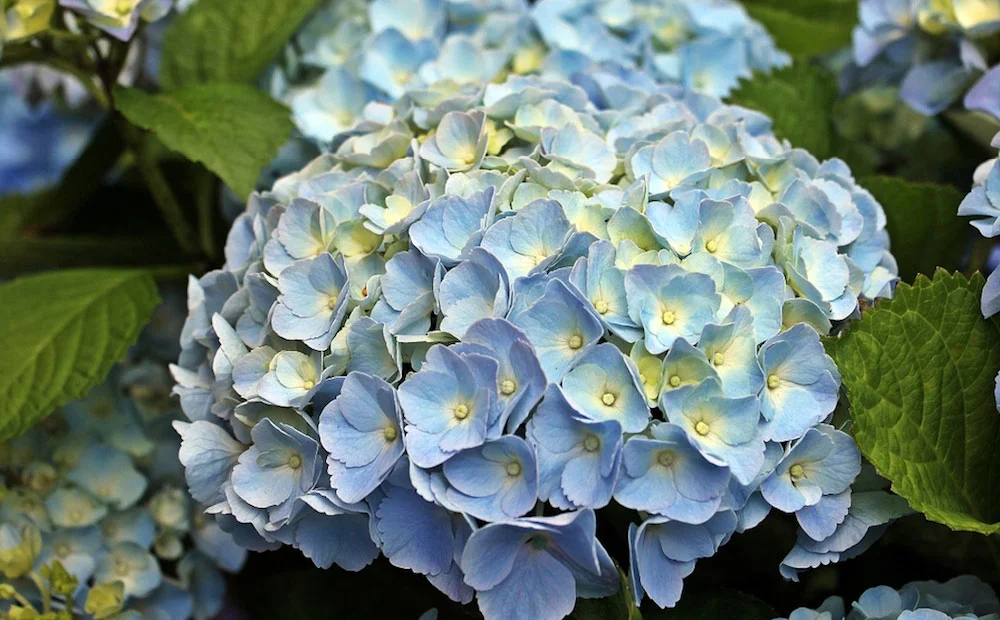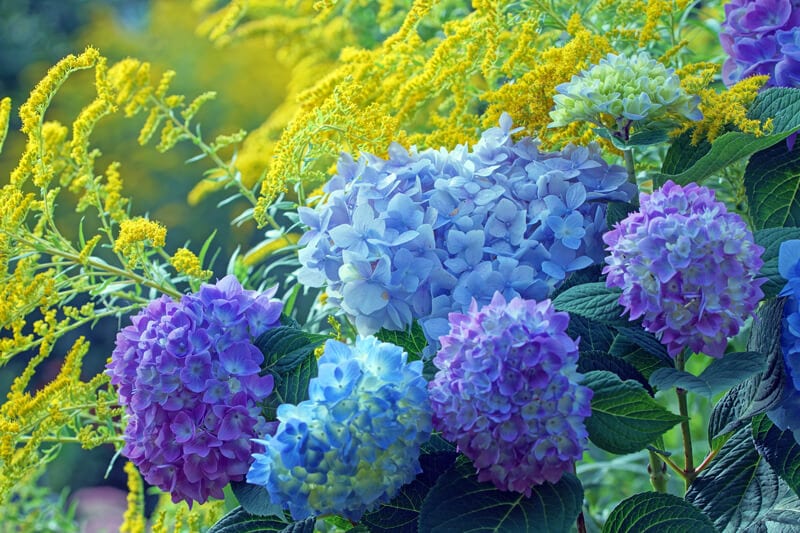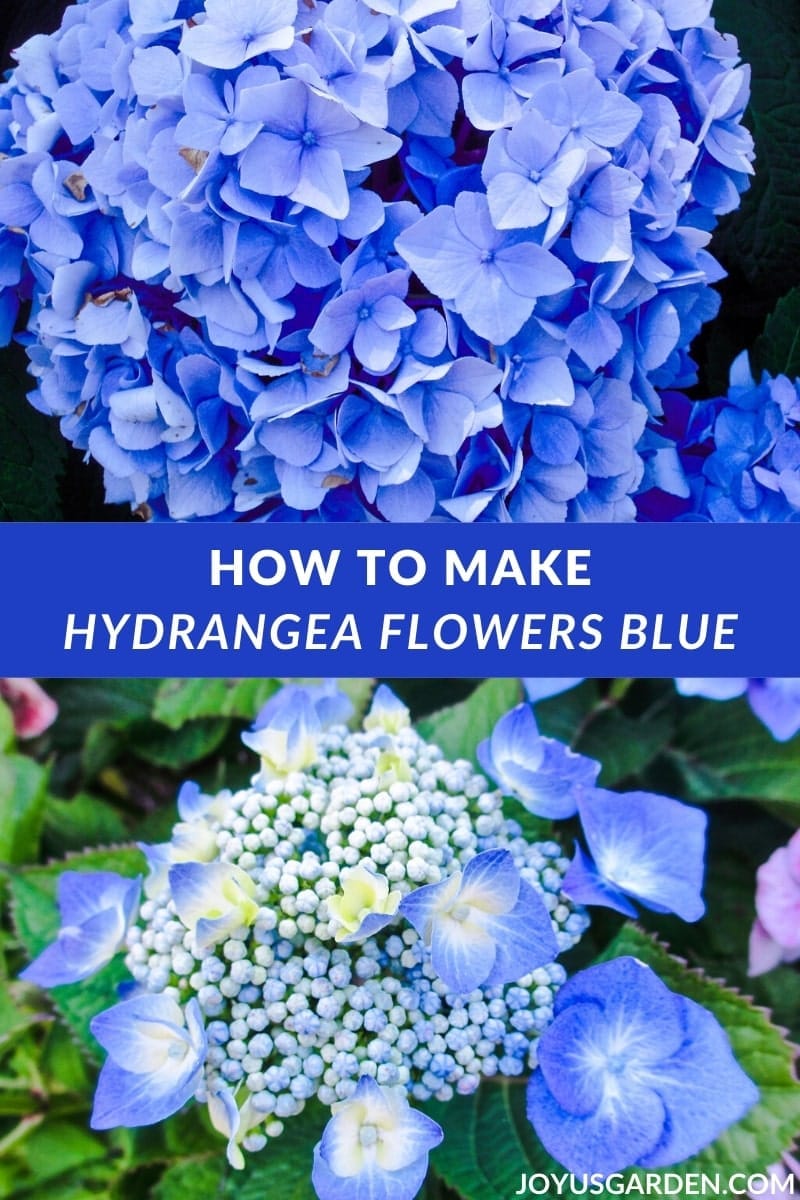Hydrangea flowers turn blue due to the presence of aluminum ions in the soil, which are absorbed by the plant’s roots and transported to the petals, causing a chemical reaction that changes their color. This natural phenomenon occurs when the soil pH is acidic, typically with a pH below 5.5.
Hydrangeas are known for their stunning blue hues, which make them a popular choice for gardeners looking to add a touch of vibrant color to their landscapes. The ability of these flowers to change their color depending on the soil conditions adds to their allure and makes them a fascinating plant to grow.
In this blog post, we will explore the factors that contribute to the blue coloration of hydrangeas and discuss how you can manipulate the soil to achieve the desired shade of blue. So, let’s dive in and uncover the secrets behind what makes hydrangeas blue.

Credit: www.dammannsgardenco.com
The Allure Of Blue Hydrangeas
The allure of blue hydrangeas lies in their captivating color variations. These beautiful flowers come in shades ranging from pale sky blue to deep indigo, making them a popular choice for gardens and floral arrangements.
The symbolism behind the hue adds to their appeal. Blue hydrangeas are often associated with serenity, calmness, and tranquility, making them a symbol of peace and relaxation. The color blue is also linked to trust, loyalty, and harmony, making blue hydrangeas a meaningful gift for loved ones.
Whether used in weddings, decorations, or as a centerpiece, blue hydrangeas bring a sense of beauty and elegance. Their vibrant blooms can brighten any space and create a soothing ambiance. With their stunning color and symbolic meaning, it’s no wonder that blue hydrangeas continue to captivate and enchant all who encounter them.
Hydrangea Basics
Hydrangeas are known for their vibrant colors, including the striking blue varieties. These flowers are native to Asia and the Americas, with over 70 species in total. The color of the hydrangea is influenced by the pH level of the soil, with acidic soils producing blue flowers and alkaline soils resulting in pink flowers.
In terms of cultural significance, hydrangeas are often associated with gratitude, grace, and abundance. In Japan, they are seen as a symbol of apology and heartfelt emotion.
These beautiful blooms have also been linked to compassion and understanding in various cultures. Whether used in floral arrangements or enjoyed in gardens, hydrangeas continue to captivate with their alluring shades of blue.
The Science Of Color Change
The color of hydrangea flowers is determined by the pH levels of the soil in which they are planted. In acidic soils, the flowers tend to be blue, while in alkaline soils, they become pink. This color change is due to the presence of aluminum ions, which are more available to the plant in acidic conditions.
The acidic environment allows the plant to absorb aluminum ions, which in turn influences the pigmentation of the flowers. When the soil is more alkaline, the aluminum ions are less available, resulting in a shift towards pink flowers.
Understanding the relationship between pH levels and pigmentation is crucial for gardeners who want to manipulate the color of their hydrangea blooms.
Soil Composition And Hydrangea Color
The blue color of hydrangea flowers is influenced by the soil’s aluminum levels. Acidic soils with high aluminum content lead to blue blooms, while alkaline soils produce pink flowers. This natural phenomenon highlights the impact of soil composition on the coloration of hydrangeas.
| Soil Composition and Hydrangea Color |
|---|
| The color of hydrangea flowers can vary depending on the soil composition. One way to achieve blue hydrangeas is to test the soil pH. Acidic soil with a pH between 5.0 and 5.5 allows the plant to absorb aluminum, which turns the flowers blue. On the other hand, alkaline soil with a pH between 6.0 and 6.2 results in pink or red hydrangeas. |
To modify soil properties, add aluminum sulfate to acidify the soil and increase acidity. If the soil is too alkaline, add garden sulfur to lower the pH level. However, it is important to note that these changes should be made gradually over time to avoid shocking the plant. Regular soil testing is also recommended to ensure the soil pH remains within the desired range. By understanding the relationship between soil composition and hydrangea color, you can create a beautiful and vibrant garden. |
Caring For Blue Hydrangeas
Hydrangeas are among the most popular flowers to grow in gardens, and blue hydrangeas are especially beloved for their striking color. To keep your blue hydrangeas looking their best, it’s important to provide them with optimal growing conditions.
| Optimal Growing Conditions | Maintaining Vibrant Blue Flowers |
|---|---|
| Plant in well-draining soil with a pH between 5.2 and 5.5. | Test the soil’s pH regularly and adjust as needed with aluminum sulfate or garden lime. |
| Provide plenty of sunlight, but protect from intense afternoon sun. | Water regularly, keeping the soil evenly moist but not waterlogged. |
| Mulch around the base of the plant to retain moisture and regulate temperature. | Apply a fertilizer high in phosphorus to promote flower growth and maintain blue color. |
By following these guidelines, you can enjoy beautiful, vibrant blue hydrangeas in your garden for years to come.

Credit: sponzilli.com
Fertilizers And Additives
Hydrangeas turn blue due to the presence of aluminum ions in the soil. Aluminum sulfate or other aluminum-containing fertilizers can be added to the soil to make the hydrangea blooms more vibrant and blue. These additives help lower the soil pH, making it more acidic and enabling the plant to absorb aluminum ions.
| Fertilizers and Additives |
|---|
| Choosing the Right Products |
Hydrangeas are known for their vibrant colors, and blue is a popular choice among gardeners. One of the factors that contribute to the blue color of hydrangeas is the soil pH. To keep your hydrangeas blue, you need to use the right fertilizers and additives. When choosing fertilizers, look for products with low phosphorus content and high potassium content. Phosphorus can prevent the absorption of aluminum, which is essential for blue hydrangeas. You can also add aluminum sulfate to the soil to increase the acidity, which will help the plant absorb aluminum. When applying fertilizers and additives, follow the instructions carefully to avoid overfeeding or damaging the plant. By choosing the right products and applying them correctly, you can enjoy the beauty of blue hydrangeas in your garden. |
Common Misconceptions
Blue hydrangeas are a popular and beautiful addition to any garden. However, there are many misconceptions surrounding what makes hydrangea blue. One of the most common myths is that the acidity of the soil determines the color of the flowers.
While soil acidity does play a role, it is not the only factor. Another myth is that adding aluminum sulfate to the soil will turn the flowers blue. While aluminum sulfate can lower the pH of the soil and increase the availability of aluminum, too much can be harmful to the plant.
To avoid common mistakes, it is important to test the soil pH before planting and adjust it accordingly. It is also important to follow proper fertilization techniques and avoid over-fertilization. By understanding the true factors that contribute to blue hydrangeas, you can enjoy a beautiful and vibrant garden for years to come.
Troubleshooting Hydrangea Colors
When it comes to hydrangea colors, troubleshooting can be a challenge. If your hydrangeas won’t turn blue, consider the soil pH. Acidic soil with a pH below 5.5 helps maintain their blue color. Dealing with color fading may require adding aluminum sulfate to the soil. Ensure the plants receive adequate sunlight and water, as these factors also impact their color.
In addition, choosing the right hydrangea variety is crucial. For instance, the ‘Nikko Blue’ and ‘Endless Summer’ hydrangeas are known for their stunning blue blooms. By addressing these factors, you can enjoy vibrant blue hydrangeas in your garden.
Innovations In Hydrangea Breeding
Hydrangea breeding has seen remarkable innovations in the quest to understand what makes them blue. These advancements have revealed the key factors influencing the vibrant blue hues, leading to improved breeding techniques and more stunning blue hydrangea varieties.
| Innovations in Hydrangea Breeding |
Hydrangeas are fascinating flowers, and developments in horticulture have led to exciting advancements in their breeding. Through innovative techniques, specialists have been able to enhance the color spectrum of hydrangeas, particularly the elusive blue hue. This has captured the imagination of gardening enthusiasts, sparking an interest in the future of blue hydrangeas. The potential for further breakthroughs in hydrangea breeding is generating a buzz in the horticultural community. |
Beyond The Garden: Blue Hydrangeas In Culture And Design
Blue hydrangeas are not just limited to the garden; they have found their way into various aspects of culture and design. These stunning flowers have become popular choices for floral arrangements, adding a touch of elegance and vibrancy to any setting.
With their bold blue hues, blue hydrangeas can serve as the focal point or complement other flowers in a bouquet. Their versatility allows them to be paired with different colors and varieties, creating unique and visually appealing arrangements.
Whether used in weddings, special events, or home decor, blue hydrangeas bring a sense of beauty and charm. Their captivating presence can enhance the overall aesthetic and create a serene atmosphere.
So next time you are considering floral arrangements, don’t forget the captivating allure of blue hydrangeas. Incorporate them into your designs and experience the beauty they bring to any occasion.

Credit: www.joyusgarden.com
Frequently Asked Questions
How Do I Turn My Hydrangeas Blue?
To turn your hydrangeas blue, you can adjust the soil’s pH level. Acidic soil, with a pH of around 5. 5, helps hydrangeas absorb aluminum, which turns their flowers blue. Add aluminum sulfate or acidic compost to the soil to lower the pH and achieve those beautiful blue blooms.
Do Coffee Grounds Turn Hydrangeas Blue?
Yes, coffee grounds can turn hydrangeas blue. The acidic nature of coffee grounds lowers the pH of the soil, making it more acidic. This acidic environment allows hydrangeas to absorb aluminum from the soil, which turns their blooms blue.
Can Hydrangeas Be Naturally Blue?
Yes, hydrangeas can naturally be blue based on the pH level of the soil they are planted in.
Will Vinegar Turn Hydrangeas Blue?
Yes, vinegar can turn hydrangeas blue. By acidifying the soil, vinegar lowers the pH level, allowing the plants to absorb aluminum, which gives the flowers a blue color. Be cautious not to use too much vinegar, as it may harm the plants.
Conclusion
The blue color of hydrangea flowers is a result of a fascinating process known as pH-dependent color change. The acidity or alkalinity of the soil directly affects the availability of aluminum ions, which in turn influences the color of the petals.
By understanding the factors that contribute to the blueness of hydrangeas, gardeners can manipulate the soil pH to achieve their desired hue. So, whether you’re aiming for vibrant blue blooms or experimenting with other colors, the key lies in the delicate balance of soil chemistry and plant physiology.
Happy gardening!
- How to Turn Hydrangeas Blue Quickly? Pro Gardener Secrets - September 8, 2024
- Why is My Hydrangea Drooping?: Revive Your Blooms! - September 8, 2024
- Hydrangea Leaves Brown Spots: Causes & Quick Fixes - September 8, 2024
